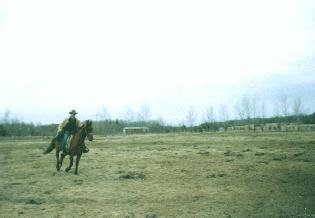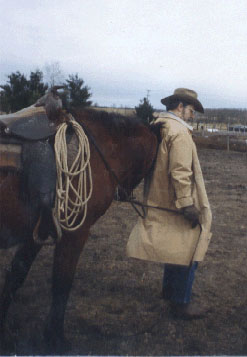
...And I had to write at least one column about the lack of a good system of riding trails in this neck of the woods.

...And I had to write at least one column about the lack of a good system of riding trails in this neck of the woods.
 Horses, horses everywhere, and not a place to ride.
Horses, horses everywhere, and not a place to ride.
It's no secret that I love horses. I love the way they move, the way they sound, the way they feel and even the way they smell. I wholeheartedly agree with my friend, Dave Bird, from Deer River:
From all appearances, a lot of folks have similar sentiments. There are more privately owned horses in the U.S. today than at any time in our history -- including the so-called "Horse and Buggy" days.
Take a drive around Itasca County and you may be amazed at how many horses you see. According to one DNR employee I talked with, there are far more horses in Minnesota than snowmobiles or ATVs.
If you have children, there aren't many better ways to teach your children responsibility, accountability and alertness. A horse is also an excellent form of exercise. According to Walking magazine, riding a horse at a trot for 15 minutes burns more calories than jogging for 15 minutes. As one ancient quote puts it, "The outside of a horse is good for the inside of a man." The presenter at the recent "Girls and Adolescence" workshop remarked that association with horses even seems to contribute to a girl's spiritual development.
The primary downside to working with horses is the risk of physical harm. Insurance company statistics reveal that you are 4.5 times more likely to be seriously injured while riding a horse than while riding a motorcycle. So what can you do with your horse while keeping the risk of accidents at a minimum?
For many people, the answer is the show ring. Several saddle clubs and breed associations sponsor weekend shows; and there are always the county fairs.
 Not everyone can afford a horse of show ring quality, but a well-trained
stock or unregistered horse can still bring its owners great enjoyment.
The problem is what to do with it. Almost any use away from the home pasture
requires either trailering the horse to a trail system or a risky ride
along a roadway. One of the early lessons most riders learn is that horses
and motor vehicles are not a good mix.
Not everyone can afford a horse of show ring quality, but a well-trained
stock or unregistered horse can still bring its owners great enjoyment.
The problem is what to do with it. Almost any use away from the home pasture
requires either trailering the horse to a trail system or a risky ride
along a roadway. One of the early lessons most riders learn is that horses
and motor vehicles are not a good mix.
If you have a bicycle, ATV, snowmobile or cross-country skis, you'll have little trouble finding trails or getting to them. Try it with a horse, however. The existing trails are a nightmarish (no pun intended) mess of disjointed segments fractured by swamps, roadways, fences, bridges, barking dogs and other hazards to horse and rider alike.
A workable system of trails in Itasca County shouldn't require a lot of money, just a bit of planning, coordination and cooperation.
Let's assume, for the sake of discussion, that the local DNR trails coordinator is the logical one to put together a network of bridle trails. The first step is to mark suitable paths that already exist on public lands. Most hunters know that DNR fire plan maps contain hundreds of miles of hunting trails, old logging roads, power and pipeline right-of-ways, etc. It would help matters if horse-friendly private landowners would voluntarily inform the coordinator of any suitable right-of-ways that they would be willing to make available. At this stage, we'd have hundreds of miles of trails in Itasca County alone, but mostly in disconnected segments.
Now comes the difficult part: connecting the dots.
There's a lovely trail on public land just east of Grand Rapids. Unfortunately, the western end dead-ends against private land a mere quarter-mile from a public road. I know of at least two ways to connect those dots that would require little more than a signature on a piece of paper. The result would eliminate as much as three miles of sometimes dangerous road riding for dozens of horses in the Gunn Road area. But someone with governmental authority needs to negotiate an arrangement that will protect the landowners' interests.
On other trail segments, a little help from the DNR Wetlands people could result in re-routing swampland trails onto higher ground-- turning winter-only trails into something of benefit to hikers and horse riders alike. As for clearing brush and overhead branches along the new right-of-ways, I'm sure the saddle clubs, Boy Scouts, 4-H, and other groups would be willing to lend a hand. To top it off, a few boxes of little trail markers would keep riders from accidentally straying into someone's backyard. (Yep, it's happened to me more than once.)
Horse owners, if these ramblings make sense to you, why not give the DNR Regional Trails Office a call at 327-4408. Tell them that you'd like to see an organized system of bridle trails-- and offer to help them make it. The neck you save may be your own.
![]() Return
to Table of Contents
Return
to Table of Contents
![]() Return to Cowboy Bob's Home Page
Return to Cowboy Bob's Home Page
![]() Return to Cowboy Bob's Home Page
Return to Cowboy Bob's Home Page
COPYRIGHT © 1999 BOB LEMEN, GRAND RAPIDS, MINNESOTA. ALL RIGHTS RESERVED.